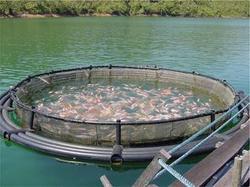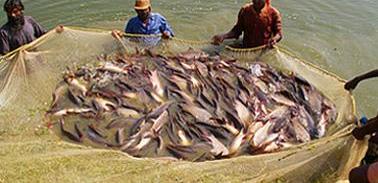Rohu Fish Farming Guide:

Introduction of Rohu Fish Farming:- Rohu (Roho Labeo or Labeo rohita) is one of the freshwater fishes of the carp family which is very popular fish in India and other parts of the world especially south-east Asia. This fish also called as ”Rui” or “Ruee” or Tapra. Rohu fish belongs to the family of “Cyprinidae” and genus of “Labeo”. Among all carp fishes, Rohu fish is popular due to its taste and market demand. Farmers can expect good profits in Rohu farming with good farm management practices. In South India, This fish is mainly served as fried fish in any kind of parties. People often confuse between Rohu and Catla fish, because they look similar in shape and size.
Local Names of Rohu Fish in India:- Rohu, Rue, Roho Labeo, Carpo Fish (English), Rehu, Tambada Massa (Hindi), Kannadi Kendai (Tamil), Rohu / Rovva / Bocha Gnadu Meen (Telugu), Rohu, Rohitham (Malayalam), Rui(Bengali), Rohu (Kannada),Rohu(Marathi).
Rohu Fish Breed Characteristics:- The following are the physical characteristics of the Rohu Fish.
- Rohu fish has a thick body with a narrow head and tail compared to Catla fish and head weight is less in Rohu when compared with catla fish.
- Rohu fish body is covered with full of scales except for fins and head. Apart from this, the head is triangulated.
- Rohu body surface and under surface is in brown color.
- Rohu fish belly is in silver color and there is a total of 7 fins in the body of Rohu fish.
- The max length that Rohu fish can attain is 1 meter.
- The body is slightly curved to the upper side and it has 2 pairs of the nostril.
- Generally, the scales of Rohu fish are in reddish color except for the belly part.
Read: Rohu Fish Farming Project Report.
Breeding in Rohu Fish Farming:- Usually, Rohu fish gain maturity at the age of three years and a female Rohu fish contains about 3 lakhs eggs. The best season for egg laying is from April to July. Rohu fish lays eggs in open waters and don’t lay eggs in stagnant water.
Seed Collection in Rohu Fish Farming:- The commercial Rohu fish breed culture is common and induced breeding is playing a major role for entire seed requirement in all the countries. However, Rohu seed source is available from freshwater rivers, lakes, reservoirs, canals and other open water bodies. The best source for main quality seed collection is the local hatcheries.

Rearing Fingerlings in Rohu Fish Farming:- Rohu fry should be reared along with mrigala and catla at equal proportions with combined densities of 0.2 to 0.3 million fry per 1-hectare pond. Generally, the nursery raised fry of 25 mm length Rohu should be reared further for the length of 100 mm and weight of 10 grams to 15 grams fingerlings to raise in the main pond.
Pond Construction in Rohu Fish Farming:- Pond construction plays a major role in commercial freshwater fish culture farming. Heavy stocking with Rohu fish is not recommended and this always depends on the fish fingerlings size and pond area. Rohu fish grows well at water temperatures between 25°C to 36°C.
Seed Stocking and Fertilizers in Rohu Fish Farming:- Organic, inorganic fertilizers, and supplementary feeding should be provided in the pond along with the mixture of oil cake, rice bran, wheat flakes. The application dosage depends on the farming intensity and inherent productivity. Generally, the survival rate of Rohu fingerlings ranges from 60 to 80 %. Contact nearest aquaculture or fisheries department for exact pond manures and fertilizers needed for high yield and quick growth.
Feeding in Rohu Fish Farming:- Rohu fish takes the feed from the middle level of water and the main feed of Rohu fish is plant and putrescent organic substances. As part of commercial farming, rice dust, cake, cracked wheat, and fish mean can be served as supplementary feed in the pond to gain good weight in a short period of time.
Harvesting in Rohu Fish Farming:- Rohu fish can be collected from the pond by using the fishing nets when they attain at least 500 grams. Generally Rohu fish has good market demand when they gain about 1 kg to 2 kg each. Harvesting can be done based on the fish size and local market demand.

Market Demand for Rohu Fish:- In India, there is a huge demand for Rohu fish. Most of the restaurants/hotels serve this fish. Especially, in south India, people make fish fry or fish curry with Rohu fish. The regular market price for Rohu fish is about 120 to 160 rupees per kg. Depending on the size, farmers can market Rohu fish local markets, function halls, and hotels.
For murrel fish farming: Read here.
For prawn farming: Read here.
For katla fish farming: Read here.
For sheep and goat farming information: Read here.
Hello ,
What is average period for rohu fish to reach weight upto 1kg.?
Well, it depends on feed ration. You can expect 3 months to gain 1 kg weight with feed, in natural waters it may take 6 months to gain 1 kg weight.
Even with proper feeding with balanced diet, Rahu grows very slow . Reaches 1 kg in 2 years
Hello
Is rohu and catla is suitable for indoor farming..i mean aquaponics
Yes.
No, they grow very slow indoor. Pond size should be more than one acear for better growth.
Can rohu be farmed in Recycled Aquaculture System?
Yes.
I AM FROM GUJARAT I AM INTERESTED IN THIS SOURCE CAN U GIVE ME CONTACT IN GUJARAT.
I want to start Indoor Fish Farming project in Maharashtra. Please guide..
You can read here about Fish farming Business.
You can read about Tilapia Fish Farming.
Dear sir
Can I raise Rohu and Katla fish in Jabalpur in open pond having 5 feet depth.
It is better to have little more depth as we don’t fill the water fully,
Hi I want to start small fish farm in home Coimbatore on trail basis I have bore water with TDS level around 200, guide me whether Rohu or Katla or some other fish which is suitable for bore well water
Can the Commercial Fish Farming be done in a deep reservoirs (upto 25 Ft Deep)? What is the commercial viability for the same?
Sir, what is the best time for feeding Rohu fish in winter season?
Usually 2 to 3 times feeding is carried out. Morning and evening are the best times.
How many Katla or Rohu fish can I keep in 0.2 acres pond? Or if I do hatchery, how many fish can I keep? And what is the best fish to farm.. Thanks
We are updating with Rohu fish farming project report. Check back soon.
I want to start fish farming in my open well? Can Rohu fish thrive in open well?
Yes, they can.
I want to plan for fish farming in about open land of 5000 m sq and 4 m deep. want to ask that should i leave mud or construct all side cemented.
how much can i grow in this pond.
Don’t construct the walls with cement. Leave with mud itself. However, make sure to provide some protection around the area.
i just bought 15000 sq ft of rectangular water pond in dry state for composite fish farming, can you give me a beat guide or link to prepare the ground with mahua, lime, chemical etc with measures which will give me an excellent yield, i am from South Bengal and the location is ideal for pond fisheries
HI can i do Rohu growing in RAS method .will it be cost effective than traditional pond farming of 10 acres pond..any other advanced and cost effective method for same scale plz guide me
Sir,step by step Rohu feed culture
please tell me
I want to start a fishery with RAS system . In which I want to grow Rohu , Katla and Talapia. What weight fish is best suitable for the first time introduction? And what is time duration for the growth of fish to 1kg?
How to start a fish feed manufacturing company
In one acre pond how many roho fish can grow plz suggest me?
Hi Jagdish Sir,
i am new to this field and no experience as well. So could you please guide me for Rohu Fish Farming, cultivation & Fish pond Preparation initial investment and other important point that i need to consider.
i am planning to do a setup in ORISSA.
please guide me for the same.
Thank You
Abhishek
Dear sir,
I am Shailendra Rana. I am an IT engineer but I am not satisfied with this job. sir, I want to do something which is own business in agriculture so please give me best decision it.
Great if you are thinking so. Before you invest single penny You should spend good time in market /fish Mandi to understand the local fish demand. Talk to fish traders and fish seller on what species is prefered and what is the price trends in the year. What are the sources of good quality fish seeds near you at what time of year you get them. What are the sources of good fish feed near you talk to them . What you will see in YouTube of the theories may help you very little. Talking to’ existing farmers in your areas may help more .
I want to do rahu fish farming in Biofloc. If i planted the azolla grass (which is high in proetin) in the fish pond. Will it have negative impact on my fish. Will it be beneficial for ammonia control of the fish pond.
What is the weight of scales when removed from say a 1 Kg weight Rohu Fish? (Wet weight)
How much Raho Of 1 inch should stock in 1 Acer. Is there any formula exist for seed and feed ?